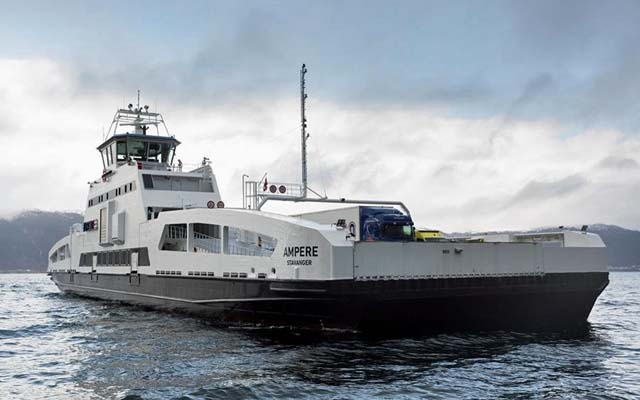Since entering service in 2015, the Norwegian ferry ‘Ampere’ has now sailed a distance equivalent to 17 times around the equator on batteries alone, which battery supplier Corvus Energy regards as a ground-breaking achievement in sustainable maritime transport.
After 10 years, Ampere continues to showcase the potential of electric propulsion technology. Many initially doomed the project, but despite this, the vessel has successfully demonstrated a model that has now been adopted in hundreds of other ferries.
Norway has earned a reputation as a leader in green shipping due to electrification of its ferry fleet, starting with the Ampere and a bold decision by the Norwegian Public Roads Administration to require sustainable technology onboard the newbuild destined to transport passengers and vehicles across the Sognefjord on Norway’s west coast. Ferry operator Norled began exploring electric alternatives and initiated a collaboration with Fjellstrand Shipyard to find the best solution. Norled went on to win the ferry tender based on the design of the Ampere.
Edmund Tolo, Fjellstrand R&D and Sales Manager, said: “When Fjellstrand Shipyard first started looking at electric ferries back in 2010, we knew that a fully electric ferry would be a challenge on this route due to the distance and power demands. However, when the tender came out, and Norled wanted to make this ferry all-electric, we revisited the idea and found solutions that we thought could work. By leveraging existing, proven vessel designs from previous projects and using our expertise in lightweight and optimised energy designs, we managed to create a vessel that is not only efficient but also fully aligned with the future of sustainable transport. We faced a series of challenges, as nobody had done this previously. We had no idea about the actual lifetime of the batteries, and we did not have the needed rules and regulations. However, by collaborating closely with Siemens as integrator, battery supplier Corvus Energy, the shipowner Norled, as well as the Norwegian Maritime Authorities and DNV, we managed to make this a success.”
Heidi Wolden, CEO Norled, added: “Our experience with this vessel shows that it pays off to invest in electric ferry operations, both for the environment and for society by creating new jobs in the maritime industry and because electric operation is cheaper than diesel in the long term. Ampere earlier accounted for 4% of our fleet with zero emissions, but we now have close to 50% of our fleet with low to zero emissions. Going forward we will work on getting more vessels to low and zero emissions.”
Launched on the Lavik-Oppedal route, Ampere’s electric propulsion system has significantly reduced the environmental impact of ferry travel. CO2 emissions were reduced by 5,700t annually. Compared to a traditional fossil-fuelled ferry, the operational cost per crossing has been reduced by 85% to 90%, generating total savings of nearly US$ 15m.
Fredrik Witte, CEO Corvus Energy, said: “Since 2015, the Ampere has crossed the Sognefjord more than 124,000 times and proven that electrical vessels are both economical and sustainable. The demonstrated cost and emissions savings paved the way for the electrification of another 80-90 ferries in Norway. It has also accelerated the technology development enabling lightweight and more energy-dense systems. To compare, the Ampere has 1 MWh of our first-generation batteries installed, but our largest system to date, which will power the Incat ferry in South America, will have almost 42 MWh of our lightweight Dolphin batteries onboard. But without the Ampere as our pilot project, we wouldn’t be where we are today in marine electrification.”
Ampere’s success has not only demonstrated the practicality of electric ferries in Norway, but has also accelerated the adoption of similar technology in coastal cities and island communities worldwide. Ampere continues to inspire sustainability-focused initiatives in the maritime sector and beyond. With the recent installation of additional batteries to prolong the vessel’s lifetime, the Ampere will continue to sail until the next innovation is in place: four autonomous ferries are set to operate the route from 2026.
Image: The first all-electric ferry, ‘Ampere’ has now sailed for 10 years on clean energy (source: Corvus/Blue-C)



